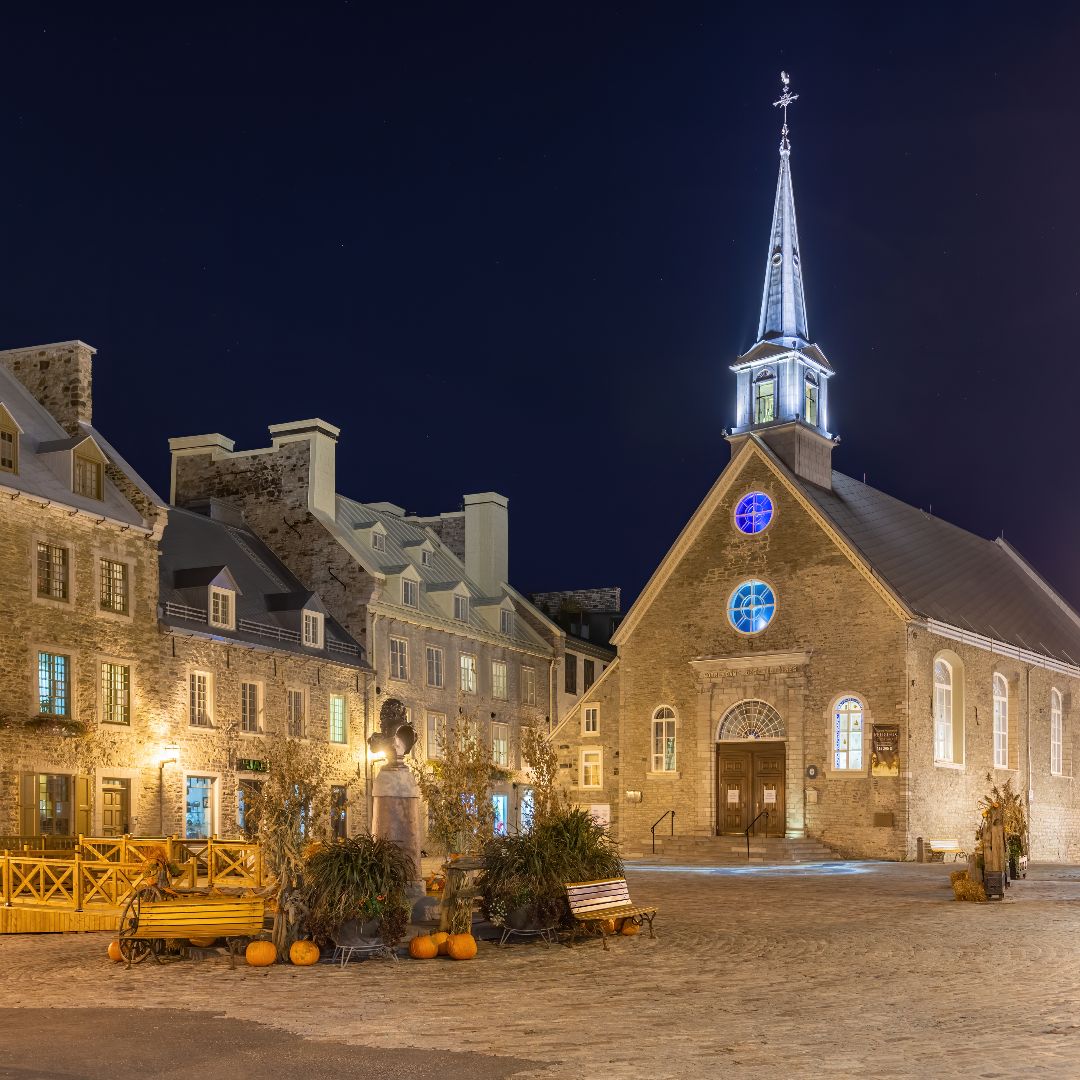Quebec
Quebec City is the capital of the province of the same name, located in eastern Canada. Founded by Samuel de Champlain in 1608, it is a purely French-speaking metropolis and the cradle of French civilization in North America. Its historic center, a French-style walled area from the 18th century, with stone buildings and narrow streets, is located to the east of the walls and reaches the Saint Lawrence River, being the most interesting part of the city for its architecture that dating back centuries, impressive churches and chapels, entertainment areas including art and music galleries, shops and restaurants. It was declared a World Heritage Site by UNESCO in 1985. Almost 5 kilometers long, Quebec's fortifications are part of a defense system. In this area, the striking Château Frontenac hotel and the imposing Citadel of Quebec are located. The cobblestone streets of the Petit Champlain district are lined with bistros and fashion shops.
The old city (Vieux Québec), a World Heritage Site since 1985, is the most interesting sector of the city. It is located to the east of the walls and reaches the San Lorenzo River. The part located at the top of the cliffs of Cap Diamant is called Haute Ville (Upper Town), while the part at its foot, between the cliffs and the river, is known as Basse Ville (Lower Town).
The Upper City is connected to the Lower City by a steep street (Côte de la Montagne), which offers a shortcut in the form of a staircase (the Escalier Casse-Cou, literally the Neckbreaking Staircase) and also with a funicular. The Lower Town includes places such as the former church of Notre-Dame des Victoires, the oldest church in Canada, the historic district of Petit Champlain, the Place-Royal, birthplace of the founding of Quebec, the port, and the Museum of Civilization.
There are many places of tourist interest that are worth visiting, such as:
- Chateau Fontenac: It is a chateau-style hotel located in the historic center of Quebec within the Upper Town. It was designed by Bruce Price and built by the Canadian Pacific Railway company. It was designated a National Historic Site of Canada in 1981 and the site where the Allies of World War II met during the First and Second Quebec Conferences (in 1943 and 1944 respectively). During these conferences, American President Franklin Delano Roosevelt, British Prime Minister Winston Churchill, and Canadian Prime Minister William Lyon Mackenzie King discussed strategy for World War II. It is recognized as the “most photographed hotel in the world.”
- Parliament Building: Completed in 1886, the building is the historic site oldest in Quebec, where politicians have met for more than a century. Inspired by the Louvre Palace in Paris, the building is a beautiful piece of architecture, especially at night when it is illuminated. Its floor is decorated with 26 bronze statues to honor the main characters in the history of the province. From Parliament, you can easily walk to the Moors of Abraham, where in 1759, French and British troops fought for control of the city. Today, they are like Quebec's Central Park. Every day, this incredible urban green space is filled with people biking, picnicking, cross-country skiing, or snowshoeing. They are also the setting for Le Festival d'été du Québec, a huge music festival held every summer that attracts bands like The Rolling Stones, Foo Fighters and Lady Gaga, to name a few.
- Chute-Montmorency Park: Many people are surprised when they discover that there is a waterfall larger than Niagara Falls just a few minutes from Quebec. At 83 meters high, Montmorency Waterfall forms at the mouth of the Montmorency River and falls over a cliff into the St. Lawrence River. It is something you have to see, both from the city and up close in the Chute-Montmorency Park. More adventurous visitors can climb the three Via Ferrata trails, stopping at viewpoints along the way for photos, or even zipline across the falls. It offers a wide variety of outdoor activities.
- Basilica of Sainte Anne de Beaupre: It is a basilica located next to the Saint Lawrence River, 30 kilometers east of Quebec City. It was initially built for two reasons: to have a space of worship for the new inhabitants of the area and to house a statue of Saint Anne, patron saint of Quebec along with Saint John the Baptist. Before the construction of the basilica, a chapel was built in 1658 where the first statue of Saint Anne was located. It is credited by the Catholic Church with many miracles of cures for diseases. It is an important sanctuary of Catholicism, with nearly 500,000 visits by pilgrims each year.
- Museum of Civilization: It is located in a building which is a mix of old structures with modern design. Inside it presents the evolution of Canadian society with exhibits on the first nations of Quebec, the history of the province and a variety of temporary exhibits covering the evolution of global civilization.
- National Museum of Fine Arts:It has a collection of 38,000 works of art from the last four centuries. The museum has a particular interest in Quebec artists and their work, including art dating back to the French colonies that inhabited the area.
Programs at Quebec

Canada East Classic

This Fantastic (Canada-USA)

Canada Coast to Coast

Canada East Express

Canada with whales

Charms of the East (USA-Canada)

Discovering the East

New Year's Eve in Canada

Trans-Canadian
What to see in Quebec?
Château Frontenac
Quebec Parliament Building
